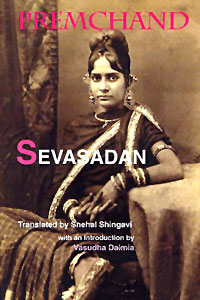Sevasadan, the first Hindi novel of Munshi Premchand represents the change of a nation erstwhile fettered by the customary fanaticism. The philosophical and the personal consequences of the change in nation owing to the influences of renaissance and the European culture happen to be the significant theme of the novel. Sevasadan emerges as an intrepid avowal on the so-called religio-political debates concerning marriage, sexuality and prostitution when the time was ripe to consider the women as the standard bearers of the nation-the nation, which was experiencing a transformation. An insightful probing into the contemporary social problems, Sevasadan portrays the hypocrisy of the so-called pillars of society, who are the authentic reflection of falsity in their sacrifice of all the orthodoxy behind the closed doors but do not dodge from mouthing moral platitude in public. Besides being a social document, Sevasadan is also the psycho anatomy of the young urban men and women as the poor prey of the monstrous society.
 Author: - Munshi Premchand, whose original name was Dhanpat Rai Srivastava, was born on 31 July 1880. Born in a period of transition, Munshi Premchand as a sensitive observant, points out the social evils, as the corollary of social echelon and the apathy towards the women. Shifted from the arty language and heroes as the themes of the Hindi novels, Premchand in the colloquial terms depicted the existence of the common people in the mainstream of society. Contemporary era, pregnant with the realistic issues like, communalism, corruption, zamindary, debt, poverty and the usage of the women as a mere object of sexuality were the principal themes of his novels.
Author: - Munshi Premchand, whose original name was Dhanpat Rai Srivastava, was born on 31 July 1880. Born in a period of transition, Munshi Premchand as a sensitive observant, points out the social evils, as the corollary of social echelon and the apathy towards the women. Shifted from the arty language and heroes as the themes of the Hindi novels, Premchand in the colloquial terms depicted the existence of the common people in the mainstream of society. Contemporary era, pregnant with the realistic issues like, communalism, corruption, zamindary, debt, poverty and the usage of the women as a mere object of sexuality were the principal themes of his novels.
Synopsis: - Steeped in the background of 20th century Baranasi, Sevasadan delineates the story of Suman, brought up in extravagance, who finds herself locked in the unhappy marriage to an older man living in a straitened condition. Denied of warmth in conjugal relationship and socially neglected Suman earns fane as a paramour. But it was the time when the educated intellectuals and the social reformers in the name of rectification organized the movement to eradicate the entire feudal culture and the outcome of that culture- the courtesanship. The key conflict in the novel lies here. The so-called social reformers do not bother to detect the conditions and the situations of the concubines, rather considered them as the infectious maggot of the holy society made by them. The tragic theme intensifies when Suman was determined by the debates between the hedonists, reformers, and religious conservatives, and the solutions they offer threaten to destroy her life and that of those around her.



















